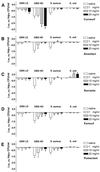Influence of modified natural or synthetic surfactant preparations on growth of bacteria causing infections in the neonatal period
- PMID: 10973461
- PMCID: PMC95962
- DOI: 10.1128/CDLI.7.5.817-822.2000
Influence of modified natural or synthetic surfactant preparations on growth of bacteria causing infections in the neonatal period
Abstract
Connatal bacterial pneumonia is common in neonates. Animal studies and initial clinical reports indicate that surfactant dysfunction is involved in the pathophysiology of severe neonatal pneumonia. Since respiratory distress syndrome and connatal pneumonia may be difficult to differentiate in the first hours of life, neonates with respiratory failure due to bacterial infections might receive surfactant. Under such conditions surfactant components might be catabolized by bacteria and promote bacterial growth. We therefore investigated the influence of three modified natural (Curosurf, Alveofact, and Survanta) and two synthetic (Exosurf and Pumactant) surfactant preparations on the growth of bacteria frequently cultured from blood or tracheal aspirate fluid in the first days of life. Group B streptococci (GBS), Staphyloccocus aureus, and Escherichia coli were incubated in a nutrient-free medium (normal saline) for 5 h at 37 degrees C, together with different surfactants at concentrations of 0, 1, 10, and 20 mg/ml. With the exception of E. coli, incubation in saline alone led to a variable decrease in CFU. In the presence of Alveofact, Exosurf, and Pumactant the decline in bacterial numbers was less marked than in saline alone. Curosurf was bactericidal in a dose-dependent fashion for GBS and had a strong negative impact on the growth of a GBS subtype that lacked the polysaccharide capsule. In contrast, Survanta (10 and 20 mg/ml) significantly promoted the growth of E. coli, indicating that surfactant components may actually serve as nutrients. We conclude that bacterial growth in different surfactant preparations is influenced by microbial species and the composition and dose of the surfactant. Further studies are necessary to elucidate the mechanisms behind our findings and to evaluate the effects of surfactant on bacterial growth in vivo.
Figures


References
-
- Baker C J, Edwards M S. Group B streptococcal infections. In: Remington J S, Klein J O, editors. Infectious diseases of the fetus and newborn infant. 4th ed. Philadelphia, Pa: The W. B. Saunders Co.; 1995. pp. 980–1054.
-
- Coonrod J D, Varble R, Jarrells M C. Species variation in the mechanism of killing inhaled pneumococci. J Lab Clin Med. 1990;116:354–362. - PubMed
Publication types
MeSH terms
Substances
LinkOut - more resources
Full Text Sources

